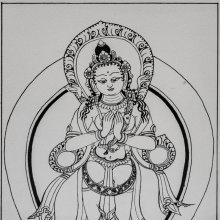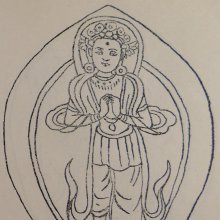Kritanjali, Kṛtañjalī, Krita-anjali, Kritamjali: 15 definitions
Introduction:
Kritanjali means something in Buddhism, Pali, Hinduism, Sanskrit, Marathi. If you want to know the exact meaning, history, etymology or English translation of this term then check out the descriptions on this page. Add your comment or reference to a book if you want to contribute to this summary article.
The Sanskrit term Kṛtañjalī can be transliterated into English as Krtanjali or Kritanjali, using the IAST transliteration scheme (?).
Images (photo gallery)
In Hinduism
Ayurveda (science of life)
Cikitsa (natural therapy and treatment for medical conditions)
Source: Wisdom Library: Ayurveda: CikitsaKṛtañjalī (कृतञ्जली) is a Sanskrit word referring to Mimosa pudica, a herb from the Fabaceae (pea) family of flowering plants. English names include “sensitive plant” or “sleepy plant”. It is used throughout Ayurvedic literature such as the Caraka-saṃhitā and the Suśruta-saṃhitā.
This plant (Kṛtañjalī) is also possibly identified with Mūrvā, a medicinal used for the treatment of all major fevers (jvara), as described in the Jvaracikitsā (or “the treatment of fever”) which forms the first chapter of the Sanskrit work called Mādhavacikitsā.

Āyurveda (आयुर्वेद, ayurveda) is a branch of Indian science dealing with medicine, herbalism, taxology, anatomy, surgery, alchemy and related topics. Traditional practice of Āyurveda in ancient India dates back to at least the first millenium BC. Literature is commonly written in Sanskrit using various poetic metres.
Purana and Itihasa (epic history)
Source: archive.org: Shiva Purana - English TranslationKṛtāñjali (कृताञ्जलि) refers to the “palms joined in reverence”, according to the Śivapurāṇa 2.2.19. Accordingly as Brahmā narrated to Nārada:—“[...] then Viṣṇu stood up. Approaching Śiva with palms joined in reverence [viz., kṛtāñjali] and accompanied by Lakṣmī, the Garuḍa-vehicled God Viṣṇu spoke thus. [...]”.

The Purana (पुराण, purāṇas) refers to Sanskrit literature preserving ancient India’s vast cultural history, including historical legends, religious ceremonies, various arts and sciences. The eighteen mahapuranas total over 400,000 shlokas (metrical couplets) and date to at least several centuries BCE.
Yoga (school of philosophy)
Source: ORA: Amanaska (king of all yogas): A Critical Edition and Annotated Translation by Jason BirchKṛtāñjali (कृताञ्जलि) refers to “holding the palms together”, according to the Amanaska Yoga treatise dealing with meditation, absorption, yogic powers and liberation.—Accordingly, “With palms held together (kṛtāñjali), Vāmadeva bowed his head to the God and asked, ‘tell [us] the means to the state of liberation while living?’ [...]’”.

Yoga is originally considered a branch of Hindu philosophy (astika), but both ancient and modern Yoga combine the physical, mental and spiritual. Yoga teaches various physical techniques also known as āsanas (postures), used for various purposes (eg., meditation, contemplation, relaxation).
In Buddhism
Tibetan Buddhism (Vajrayana or tantric Buddhism)
Source: archive.org: The Indian Buddhist IconographyKṛtāñjali (कृताञ्जलि) or Kṛtāñjalilokeśvara refers to number 98 of the 108 forms of Avalokiteśvara found in the Machhandar Vahal (Kathmanu, Nepal). [Machhandar or Machandar is another name for for Matsyendra.].
Accordingly,—
“Kṛtāñjali is similar to [Piṇḍapātra Lokeśvara] except that here the god exhibits the Añjali against his chest with his two hands.—Piṇḍapātra Lokeśvara is one-faced and two-armed and stands on a lotus. He holds the Piṇḍapātra (the bowl) in his two hands near the navel”.
The names of the 108 deities [viz., Kṛtāñjali] possbily originate from a Tantra included in the Kagyur which is named “the 108 names of Avalokiteshvara”, however it is not yet certain that this is the source for the Nepali descriptions. Tibetan Buddhism includes schools such as Nyingma, Kadampa, Kagyu and Gelug. Their primary canon of literature is divided in two broad categories: The Kangyur, which consists of Buddha’s words, and the Tengyur, which includes commentaries from various sources. Esotericism and tantra techniques (vajrayāna) are collected indepently.
Languages of India and abroad
Marathi-English dictionary
Source: DDSA: The Molesworth Marathi and English Dictionarykṛtāñjali (कृतांजलि).—a (S) Having placed the hollowed palms one over the other.
Source: DDSA: The Aryabhusan school dictionary, Marathi-Englishkṛtāñjalī (कृतांजली).—a Having placed the hollowed palms one over the other.
Marathi is an Indo-European language having over 70 million native speakers people in (predominantly) Maharashtra India. Marathi, like many other Indo-Aryan languages, evolved from early forms of Prakrit, which itself is a subset of Sanskrit, one of the most ancient languages of the world.
Sanskrit dictionary
Source: DDSA: The practical Sanskrit-English dictionaryKṛtāñjali (कृताञ्जलि).—a. folding the hands in supplication; प्रणम्य शिरसा देवं कृताञ्जलिरभाषत (praṇamya śirasā devaṃ kṛtāñjalirabhāṣata) Bhagavadgītā (Bombay) 11.14,35; Manusmṛti 4.154.
Kṛtāñjali is a Sanskrit compound consisting of the terms kṛta and añjali (अञ्जलि).
Source: Cologne Digital Sanskrit Dictionaries: Shabda-Sagara Sanskrit-English DictionaryKṛtāñjali (कृताञ्जलि).—mfn. (-liḥ-liḥ-li) One who joins the palms of the hands, making such a sign of reverence or solicitation, reverent, respectful. m.
(-liḥ) A shrub used in medicine, also in magical portions, &c. E. kṛta made, añjali the hand joined, &c.
Source: Cologne Digital Sanskrit Dictionaries: Benfey Sanskrit-English DictionaryKṛtāñjali (कृताञ्जलि).—adj. with humble salutation, [Mānavadharmaśāstra] 4, 154.
Kṛtāñjali is a Sanskrit compound consisting of the terms kṛta and añjali (अञ्जलि).
Source: Cologne Digital Sanskrit Dictionaries: Cappeller Sanskrit-English DictionaryKṛtāñjali (कृताञ्जलि).—[adjective] humble, suppliant (cf. añjali).
Source: Cologne Digital Sanskrit Dictionaries: Monier-Williams Sanskrit-English Dictionary1) Kṛtāñjali (कृताञ्जलि):—[from kṛta > kṛ] mfn. one who joins the hollowed palms in reverence or to solicit a favour (holding the hollowed palms together as if to receive alms or an offering), standing in a reverent or respectful posture, [Manu-smṛti; Mahābhārata; Rāmāyaṇa]
2) [v.s. ...] m. a shrub used in medicine and in magical potions, [cf. Lexicographers, esp. such as amarasiṃha, halāyudha, hemacandra, etc.]
Source: Cologne Digital Sanskrit Dictionaries: Yates Sanskrit-English DictionaryKṛtāñjali (कृताञ्जलि):—[kṛtā+ñjali] (liḥ-li) a. Joining the palms of the hands for making obeisance or holding water. m. A shrub used in medicine and in magical potions.
[Sanskrit to German]
Sanskrit, also spelled संस्कृतम् (saṃskṛtam), is an ancient language of India commonly seen as the grandmother of the Indo-European language family (even English!). Closely allied with Prakrit and Pali, Sanskrit is more exhaustive in both grammar and terms and has the most extensive collection of literature in the world, greatly surpassing its sister-languages Greek and Latin.
Kannada-English dictionary
Source: Alar: Kannada-English corpusKṛtāṃjali (ಕೃತಾಂಜಲಿ):—
1) [noun] the hands joined together (as in reverence).
2) [noun] a man who has joined both the palms, expressing reverence, obeisance or supplication.
3) [noun] the sensitive plant Mimosa pudica of Mimosaceae family; touch-me-not plant.
Kannada is a Dravidian language (as opposed to the Indo-European language family) mainly spoken in the southwestern region of India.
See also (Relevant definitions)
Partial matches: Krita, Anjali.
Starts with: Kritanjalilokeshvara, Kritanjaliputa.
Full-text: Kritanjaliputa, Pragamin, Abaddhanjali, Sanjali, Dashapushpa, Sutaputra, Sutatanaya, Sutaja, Anikastha, Kritanjalilokeshvara, Lilavatara, Nara, Nilanjana, Sarvabhutesha, Anunaya, Devadeva, Samputa, Anjali.
Relevant text
Search found 12 books and stories containing Kritanjali, Krita-anjali, Kritamjali, Kṛta-añjali, Krta-anjali, Kṛtāṃjali, Krtamjali, Kṛtañjalī, Krtanjali, Kṛtāñjali, Kṛtāñjalī, Kṛtānjali; (plurals include: Kritanjalis, anjalis, Kritamjalis, añjalis, Kṛtāṃjalis, Krtamjalis, Kṛtañjalīs, Krtanjalis, Kṛtāñjalis, Kṛtāñjalīs, Kṛtānjalis). You can also click to the full overview containing English textual excerpts. Below are direct links for the most relevant articles:
Garga Samhita (English) (by Danavir Goswami)
Verse 2.12.30 < [Chapter 12 - Subduing Kāliya and Drinking the Forest Fire]
Verse 5.9.14 < [Chapter 9 - The Happiness of the Yadus]
Verse 1.19.18 < [Chapter 19 - Breaking of the Two Arjuna Trees]
The Indian Buddhist Iconography (by Benoytosh Bhattachacharyya)
Bhakti-rasamrta-sindhu (by Śrīla Rūpa Gosvāmī)
Verse 2.3.41 < [Part 3 - Involuntary Ecstatic Expressions (sattvika-bhāva)]
Verse 2.3.39 < [Part 3 - Involuntary Ecstatic Expressions (sattvika-bhāva)]
Manusmriti with the Commentary of Medhatithi (by Ganganatha Jha)
Verse 7.91 < [Section VIII - Duties in Battle (saṅgrāma)]
Brihad Bhagavatamrita (commentary) (by Śrī Śrīmad Bhaktivedānta Nārāyana Gosvāmī Mahārāja)
Verse 2.4.260 < [Chapter 4 - Vaikuṇṭha (the spiritual world)]
The Agni Purana (by N. Gangadharan)
Related products


